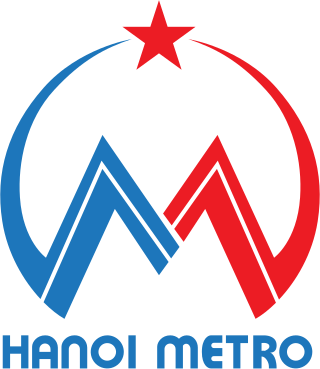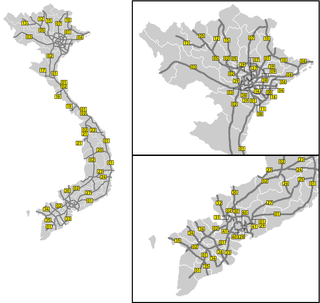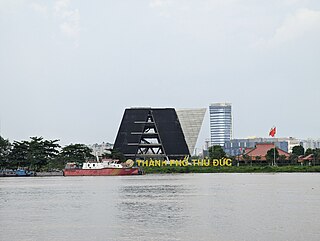
Ho Chi Minh City, also commonly known as Saigon, is the most populous city in Vietnam, with a population of around 9.3 million in 2023. Situated in the Southeast region of Vietnam, the city surrounds the Saigon River and covers about 2,061 km2 (796 sq mi).

Đồng Nai is a province in the Southeast region of Vietnam, located east and northeast of Ho Chi Minh City (Saigon). The capital city and the largest city in Đồng Nai is Biên Hòa.

Vietnam Railways is the state-owned operator of the railway system in Vietnam. The principal route is the 1,727 km (1,100 mi) single-track North–South Railway line, running between Hanoi and Ho Chi Minh City. This was built at the metre gauge in the 1880s during the French colonial rule. There are also standard gauge lines running from Hanoi to the People’s Republic of China, eventually leading to Beijing, and some mixed gauge in and around Hanoi.

The Ho Chi Minh City Metro is a planned rapid transit network that will serve Ho Chi Minh City in Vietnam.

Long Thanh International Airport is an international airport currently under construction in Long Thành district, Đồng Nai province, Vietnam, approximately 40 km (25 mi) east of Ho Chi Minh City. The Vietnamese government approved its construction on January 4, 2021. Construction began the next day on January 5, 2021, and its first phase is scheduled to be finished by 2025. The airport will serve over 100 million passengers annually when built to the maximum designed capacity. The project is the most expensive infrastructure project in Vietnam's history. It will replace the existing Tan Son Nhat International Airport as the city's main airport.
Ho Chi Minh Road or Ho Chi Minh Highway is a highway in Vietnam. It runs from the north to the south of Vietnam, west of National Route 1. The highway was named after Hồ Chí Minh.

Ho Chi Minh City metropolitan area is a metropolitan area that was in June 2008 proposed by the Ministry of Construction of Vietnam to the Government of Vietnam for approval. According to this master plan, this metropolitan area will include provinces around Ho Chi Minh City in the Southeast region and 2 provinces in the Mekong Delta region.
The North–South express railway is a proposed high speed railway in Vietnam. The line would begin in Lạng Sơn, crossing Bắc Giang, Bắc Ninh, Hanoi, Hà Tây, Hà Nam, Ninh Bình, Thanh Hóa, Nghệ An, Hà Tĩnh, Quảng Bình, Quảng Trị, Thừa Thiên-Huế, Đà Nẵng, Quảng Nam, Quảng Ngãi, Bình Định, Phú Yên, Khánh Hòa, Ninh Thuận, Bình Thuận, Đồng Nai, Bình Dương, Ho Chi Minh City, Long An, Tiền Giang, Vĩnh Long, Cần Thơ, Hậu Giang, Sóc Trăng, Bạc Liêu and ending in Cà Mau. The rail line would connect the two most urbanised areas in Vietnam, Hanoi in the North's Red River Delta in and Ho Chi Minh City in the South's Mekong River Delta. The total proposed length would be 2,070 kilometres (1,290 mi), compared with the 1,726-kilometre (1,072 mi) of the old railway line. The cost of the line is estimated at US$55.85 billion, to be funded by official development assistance from Japan and by the Vietnamese government itself. The project is planned to be implemented in three phases: Lang Son to Hanoi (170 km); Hanoi to Vinh city (285 km); Vinh City to Nha Trang (896 km); Nha Trang to Ho Chi Minh City (364 km); Ho Chi Minh City to Can Tho (139 km); Can Tho to Ca Mau (216 km). Construction activities on the first phase are expected to commence in 2020, and the whole project is scheduled for completion in 2050. This project is part of the country's railway transport development strategy by 2020 with a vision to 2050. The project is also part of the Trans-Asian railway network.

The North–South Expressway East is the most common name of an expressway in Vietnam located very close to National Route 1 an artery, smoothly between the two South and North Vietnam. Similar to National Route 1, the expressway starts from Lạng Sơn and ends at Cà Mau. In the border, the expressway will connect to Nanning-Youyiguan Expressway in China.

The railway system in Vietnam is owned and operated by the state-owned Vietnam Railways. The principal route, the single track North-South Railway running between Hanoi and Ho Chi Minh City, accounts for 1,726 kilometres (1,072 mi) of the network's total length of 2,600 kilometres (1,600 mi). The national railway network uses mainly metre gauge, although there are several standard gauge and mixed gauge lines in the north of the country.

The North–South railway is the principal railway line serving the country of Vietnam. It is a single-track metre gauge line connecting the capital Hanoi in the north to Ho Chi Minh City in the south, for a total length of 1,726 km (1,072 mi). Trains travelling this line are sometimes referred to as the Reunification Express, although no particular train carries this name officially. The line was established during French colonial rule, and was completed over a period of nearly forty years, from 1899 to 1936. As of 2005, 191 of Vietnam's 278 railway stations were located along the North–South line.

Railway crashes and derailments in Vietnam are common. In 2010, 451 railway incidents were reported across the country's railway network, having caused 211 deaths and 284 injuries. A joint Japanese-Vietnamese evaluation team reported in 2007 that the poor state of railway infrastructure was the fundamental cause for most railway incidents, of which the most common types were train crashes against vehicles and persons, especially at illegal level crossings; derailments caused by failure to decrease speed were also noted as a common cause of accidents. As of 2010, around 90% of all railway incidents occurred at level crossings without safety fences, and most were said to have been caused by motorists failing to follow traffic safety laws.

The Hanoi Metro is a rapid transit system in Hanoi, the capital city of Vietnam. Owned by Vietnam Railways and operated by Hanoi Metro Company (HMC), it is the first operational rapid transit system in Vietnam. The first line opened to service on 6 November 2021.

Line 2A, Hanoi Metro, also known as Cát Linh line, is an elevated mass transit railway line, and part of the Hanoi Metro network. It is the first rapid transit line to operate in Vietnam, and was opened for service on 6 November 2021.
The Vientiane–Vũng Áng railway is a proposed 1,435 mmstandard gauge railway that ran for 555 kilometres (345 mi) between the capital of Laos, Vientiane, and port in Hà Tĩnh Province via Mụ Giạ Pass on the border between Laos and Vietnam.

The Expressway network of Vietnam is a recent addition to the transport network of Vietnam. The first expressways were opened in the early-2000s, by 2020, the expressway network is expected to stretch 1,276 kilometres (793 mi) and plans are for over 7,000 kilometres (4,300 mi) of expressway by 2030.

The Bien Hoa–Vung Tau Expressway (CT.28) is an expressway planned in the Southeast region of Vietnam. With a total length of 77.6 km, this expressway when completed is expected to connect Dong Nai with Ba Ria - Vung Tau.. The design speed is 100 km/h and the road will have 4 lanes. According to the project proposal investment report of the Transport Design Consultancy Corporation (TEDI), the expressway is 77.6 km long. Of which, the expressway section is 66 km long, the urban road part is about 2.8 km, and the part of scale II is about 8.8 km. Of these, the section Bien Hoa - Phu My (expressway) is 38 km long; section of Phu My - coastal road of Ho Chi Minh City. Vung Tau (expressway) is 28 km long; from the coastal road of the Vung Tau City to National Route 51C is 2.8 km long and the section connecting Phu My - National Road 51 is 8.8 km long.

Thủ Đức is a municipal city (sub-city) under the administration of Ho Chi Minh City, Vietnam.
The Ho Chi Minh City–Phnom Penh railway is a proposed railway between Ho Chi Minh City, Vietnam and Phnom Penh, Cambodia. The railway is envisioned to complete the missing link on the eastern line of the Kunming–Singapore railway.






















